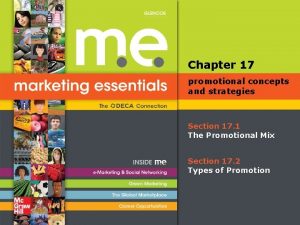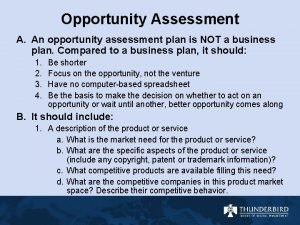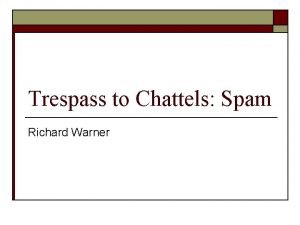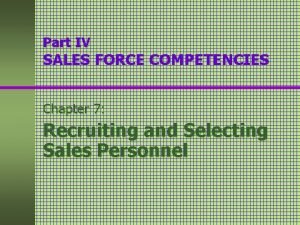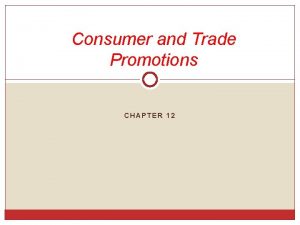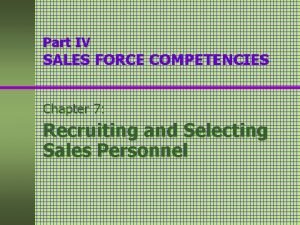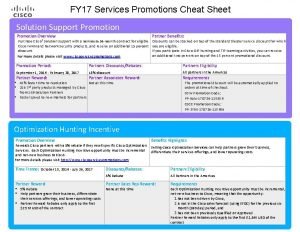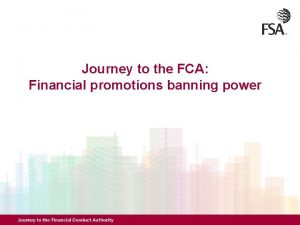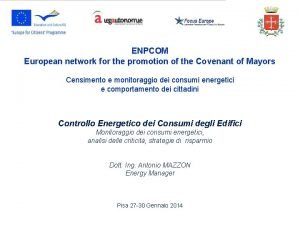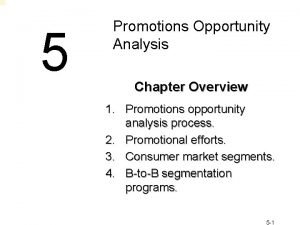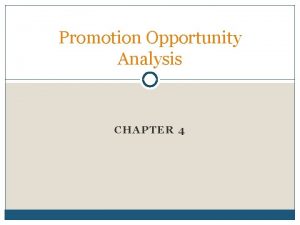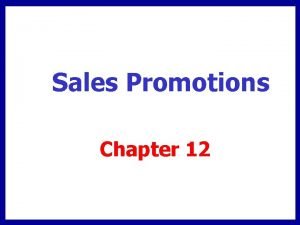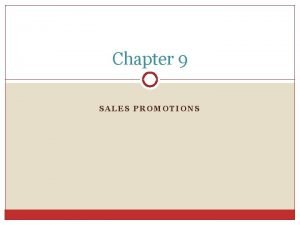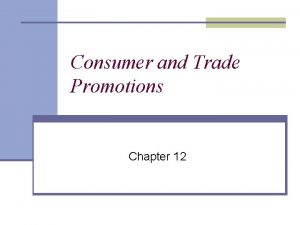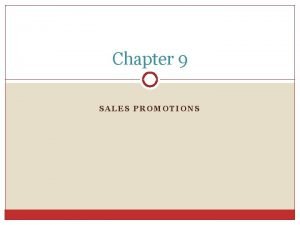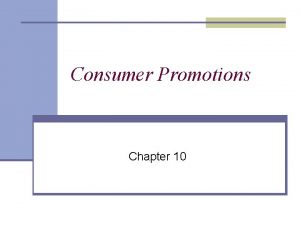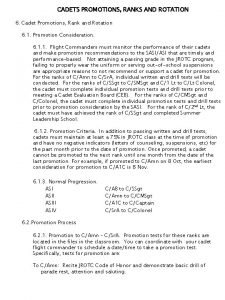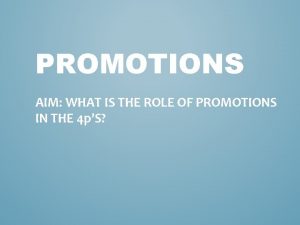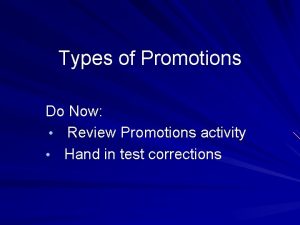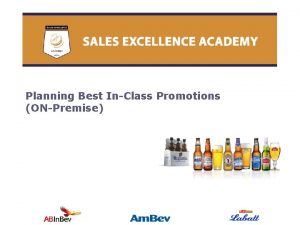4 Chapter Four Promotions Opportunity Analysis Copyright 2010







































- Slides: 39

4 Chapter Four Promotions Opportunity Analysis Copyright © 2010 Pearson Education, Inc. publishing as Prentice Hall 4 -1

4 Pets. Mart Pets are now part of the family. • Attitudes have changed. • New animal care products. • New animal care services. • Prices are secondary. Why the Change? Discussion Slide Copyright © 2010 Pearson Education, Inc. publishing as Prentice Hall 4 -2

4 Promotions Opportunity Analysis Chapter Overview 1. Promotions opportunity analysis process 2. Promotional efforts 3. Consumer market segments 4. B-to-B segmentation programs Copyright © 2010 Pearson Education, Inc. publishing as Prentice Hall 4 -3

FIGURE 4. 1 Steps in a Promotion Opportunity Analysis 1) 2) 3) 4) 5) Conduct communications marketing analysis. Establish communication objectives. Create communications budget. Prepare promotional strategies. Match tactics with strategies. Copyright © 2010 Pearson Education, Inc. publishing as Prentice Hall 4 -4

Promotions Opportunity Analysis Step 1 Conduct a Communication Market Analysis • • • Competitors Opportunities Target markets Customers Product positioning Copyright © 2010 Pearson Education, Inc. publishing as Prentice Hall 4 -5

Competitors • Identify major competitors. • Identify communication strategies and tactics of each competitor. Sources of information • Secondary data • Other people • Primary research Copyright © 2010 Pearson Education, Inc. publishing as Prentice Hall 4 -6

Opportunities • Are there customers that the competition is ignoring? • Which markets are heavily saturated? • Are the benefits of our products being clearly articulated? • Are there opportunities to build relationships using a slightly different marketing approach? • Are there opportunities that are not being pursued? Copyright © 2010 Pearson Education, Inc. publishing as Prentice Hall 4 -7

Target Markets • What benefits does each target market want from the product? • How can each target market be reached? • What appeal works best for each target market? • What needs of the target market are not being met by a competing firm? • What is the demographic and psychographic makeup of each target market? Copyright © 2010 Pearson Education, Inc. publishing as Prentice Hall 4 -8

Customers Three Types of Customers • Current company customers • The competitors’ customers • Potential customers who currently do not purchase the product but may become interested Copyright © 2010 Pearson Education, Inc. publishing as Prentice Hall 4 -9

Product Positioning • Is the perception created in the consumer’s mind regarding the nature of the company and its products relative to the competition? • Positioning is created by factors such as product quality, prices, distribution, image, and marketing communications. Copyright © 2010 Pearson Education, Inc. publishing as Prentice Hall 4 -10

FIGURE 4. 3 Product Positioning Strategies § Attributes § Competitors § Use or application § Price/quality § Product user § Product class § Cultural symbol Copyright © 2010 Pearson Education, Inc. publishing as Prentice Hall 4 -11

Promotions Opportunity Analysis Step 2 Establish Communication Objectives • • • Develop brand awareness Increase good/service category demand Change customer beliefs or attitudes Enhance purchase actions Encourage repeat purchases Build customer traffic Enhance firm image Increase market share Increase sales Reinforce purchase decisions Copyright © 2010 Pearson Education, Inc. publishing as Prentice Hall 4 -12

Promotions Opportunity Analysis Step 3 Establish a Communications Budget • Budgets based on • communication objectives • marketing objectives • Budgets vary from consumer to B-to-B markets • Unrealistic assumption to assume direct relationship between advertising and sales. Copyright © 2010 Pearson Education, Inc. publishing as Prentice Hall 4 -13

Factors Impacting Relationship Between Promotions and Sales • • • The goal of the promotion Threshold effects Carryover effects Wear-out effects Decay effects Random events Copyright © 2010 Pearson Education, Inc. publishing as Prentice Hall 4 -14

FIGURE 4. 5 A Sale-Response Function Curve Combined with the Downward Response Curve and Marginal Analysis Copyright © 2010 Pearson Education, Inc. publishing as Prentice Hall 4 -15

Carryover effects are important in advertising products such as boats. Copyright © 2010 Pearson Education, Inc. publishing as Prentice Hall 4 -16

FIGURE 4. 6 A Decay Effects Model Copyright © 2010 Pearson Education, Inc. publishing as Prentice Hall 4 -17

FIGURE 4. 7 Methods of Determining Marketing Communication Budgets • • • Percentage of sales Meet-the-competition “What we can afford” Objective and task Payout planning Quantitative models Copyright © 2010 Pearson Education, Inc. publishing as Prentice Hall 4 -18

FIGURE 4. 8 Breakdown of Marketing Expenditures Copyright © 2010 Pearson Education, Inc. publishing as Prentice Hall 4 -19

FIGURE 4. 9 Advertising Expenditures in Top 10 Countries Copyright © 2010 Pearson Education, Inc. publishing as Prentice Hall 4 -20

FIGURE 4. 10 Advertising Expenditures by Media Copyright © 2010 Pearson Education, Inc. publishing as Prentice Hall 4 -21

Restaurant Chains U. S. Market Share vs Media Ad Spending Rank Brand Market Share Media Ad Spend (Mil) Cost Per Share Pt. (Mil) (Thousands) 1 Mc. Donald’s 7. 7% $ 727. 7 $ 93. 9 2 Burger King 2. 4% $ 268. 8 $ 113. 2 3 Wendy’s 2. 3% $ 374. 7 $161. 5 4 Subway 2. 2% $ 325. 2 $150. 1 5 Taco Bell 1. 9% $ 231. 7 $125. 1 Source: “Top 10 Restaurant Chains, ” www. adage. com, accessed October 1, 2008 Copyright © 2010 Pearson Education, Inc. publishing as Prentice Hall 4 -22

Automotive Brands U. S. Market Share vs Media Ad Spending Rank Brand Market Share Media Ad Spend (Mil) Cost Per Share Pt. (Mil) (Thousands) 1 Toyota Camry 5. 4% $ 65. 6 $ 12. 1 2 Honda Accord 4. 6% $ 114. 3 $ 24. 8 3 Honda Civic 3. 9% $ 112. 0 $ 28. 7 4 Nissan Altima 3. 2% $ 132. 1 $ 41. 2 5 Chevrolet Impala 3. 1% $ 18. 8 $ 58. 5 Source: “Top 10 Auto Brands, ” www. adage. com, accessed October 1, 2008 Copyright © 2010 Pearson Education, Inc. publishing as Prentice Hall 4 -23

Shampoos/Conditioners U. S. Market Share vs Media Ad Spending Rank Brand 1 Pantene 2 3 4 5 Market Share Media Ad Spend (Mil) Cost Per Share Pt. (Mil) (Thousands) 19. 3% $ 175. 8 $ 9. 1 Suave 7. 3% $ 16. 1 $ 2. 2 Clairol Herbal Essence L’Oreal 5. 7% $ 22. 6 $ 3. 9 5. 1% $ 38. 9 $ 7. 6 Head & Shoulders 4. 9% $ 52. 5 $ 10. 7 Source: “Top 10 Shampoos/Conditioners, ” www. adage. com, accessed October 1, 2008 Copyright © 2010 Pearson Education, Inc. publishing as Prentice Hall 4 -24

Promotions Opportunity Analysis Step 4 Prepare Communication Strategies • Communication strategies are broad, long-term guidelines for the marketing communications program. • Should be linked to opportunities and threats identified by the communication market analysis. • Should fit with the company’s overall message, image, and themes. Copyright © 2010 Pearson Education, Inc. publishing as Prentice Hall 4 -25

Promotions Opportunity Analysis Step 5 Match Tactics with Strategies Tactics support the communication strategies. Examples of tactics would include: • Specific advertisements • Personal selling enticements for sales reps • Sales promotions • Special product packages and labels • Price changes • Trade discounts to retailers Copyright © 2010 Pearson Education, Inc. publishing as Prentice Hall 4 -26

FIGURE 4. 12 Advantages of Marketing Segmentation v Identify company strengths and weaknesses v Locate opportunities v Match firm’s expertise with most lucrative markets v Focus budget on specific segment Copyright © 2010 Pearson Education, Inc. publishing as Prentice Hall 4 -27

Tests to Determine if a Particular Market Segment Is Viable Ø The individuals or businesses within the segment are homogeneous. Ø The market segment is different from the population as a whole and distinct from other market segments. Ø The market segment is large enough to be financially viable to target with a separate marketing campaign. Ø The market segment must be reachable through some type of media or marketing communications method. Copyright © 2010 Pearson Education, Inc. publishing as Prentice Hall 4 -28

FIGURE 4. 13 Methods of Segmenting Consumer Markets • Demographics • Psychographics • Generations • Geographic • Geodemographics • Benefits • Usage Copyright © 2010 Pearson Education, Inc. publishing as Prentice Hall 4 -29

A Nail Cares advertisement targeted to females. Copyright © 2010 Pearson Education, Inc. publishing as Prentice Hall 4 -30

Radio Ad Directed to Children An advertisement by Junior Fitness Academy targeted to children. Click on speaker to play ad. Copyright © 2010 Pearson Education, Inc. publishing as Prentice Hall 4 -31

VALS 2 Psychographic Segmentation • • Innovators – successful, sophisticated – upscale products. Thinkers – educated, conservative, practical – durability, value. Achievers – goal-oriented, conservative, career, and family Experiencers – young, enthusiastic, impulsive, fashion, social Believers – conservative, conventional, traditional Strivers – trendy, fun-loving, peers important Makers – self-sufficient, respect authority, not materialistic Survivors – safety, security, focus on needs, price Copyright © 2010 Pearson Education, Inc. publishing as Prentice Hall 4 -32

Psychographics and Technology Psychographic Segmentation • New Enthusiasts – cutting edge, eager, high incomes/education • • Hopefuls – cutting edge, lack financial means Faithful – not eager, but not averse Oldliners – not interested in new technologies Independents – higher incomes, but do not value new technology • Surfers – ambivalent about new technology, cynical about business Copyright © 2010 Pearson Education, Inc. publishing as Prentice Hall 4 -33

Table 4. 1 Characteristics of Generation Segments Copyright © 2010 Pearson Education, Inc. publishing as Prentice Hall 4 -34

Ad targeted to seniors. Copyright © 2010 Pearson Education, Inc. publishing as Prentice Hall 4 -35

Geodemographic Segmentation • Combines • Demographic census data • Geographic information • Psychographic information • PRIZM • 62 market segments • Southside City • Towns and Gowns Copyright © 2010 Pearson Education, Inc. publishing as Prentice Hall 4 -36

FIGURE 4. 14 Methods of Segmenting B-to-B Markets • Industry (NAICS/SIC codes) • Size of business • Geographic location • Product usage • Customer value Copyright © 2010 Pearson Education, Inc. publishing as Prentice Hall 4 -37

A business-to-business advertisement based on the product usage segmentation strategy. Copyright © 2010 Pearson Education, Inc. publishing as Prentice Hall 4 -38

FIGURE 4. 15 Successful Globally Integrated Marketing Communications Tactics • • Understand the international market A borderless marketing plan Thinking globally but acting locally Local partnerships Communication segmentation strategies Market communication analysis Solid communication objectives Copyright © 2010 Pearson Education, Inc. publishing as Prentice Hall 4 -39
 Contrast trade promotions and consumer sales promotions.
Contrast trade promotions and consumer sales promotions. An opportunity assessment plan:
An opportunity assessment plan: Chapter 16 using effective promotions
Chapter 16 using effective promotions 2010 pearson education inc
2010 pearson education inc C-929-a
C-929-a Variazioni finanziarie attive
Variazioni finanziarie attive Copyright 2010 pearson education inc
Copyright 2010 pearson education inc Copyright 2010 pearson education inc
Copyright 2010 pearson education inc Copyright 2010
Copyright 2010 Copyright 2010
Copyright 2010 Copyright 2010 pearson education inc
Copyright 2010 pearson education inc Copyright 2010 pearson education inc
Copyright 2010 pearson education inc Copyright 2010 pearson education inc
Copyright 2010 pearson education inc Copyright 2010 pearson education inc
Copyright 2010 pearson education inc Copyright 2010 pearson education inc
Copyright 2010 pearson education inc Copyright 2010 pearson education inc
Copyright 2010 pearson education inc Pearson education inc all rights reserved
Pearson education inc all rights reserved An opportunity has four essential qualities it is
An opportunity has four essential qualities it is An opportunity has four essential qualities it is
An opportunity has four essential qualities it is The role of imc in the marketing process
The role of imc in the marketing process Business promotions
Business promotions Compuserve v cyber promotions
Compuserve v cyber promotions Isagenix pib bonuses
Isagenix pib bonuses Promotion personal selling
Promotion personal selling Nnn promotions interview questions
Nnn promotions interview questions Consumer and trade promotions
Consumer and trade promotions Grandstand managers day
Grandstand managers day Randolph brooks federal credit union austin texas
Randolph brooks federal credit union austin texas Raoul bridgepoint
Raoul bridgepoint Nnn promotions interview questions
Nnn promotions interview questions Business promotions
Business promotions Cisco incentives and promotions
Cisco incentives and promotions Nnn promotions interview questions
Nnn promotions interview questions Business promotions
Business promotions Fca financial promotions
Fca financial promotions Fonti payback
Fonti payback Afi first sergeant
Afi first sergeant Stress is a feeling thats
Stress is a feeling thats Promotions aksioma
Promotions aksioma Promotions o'cool
Promotions o'cool
